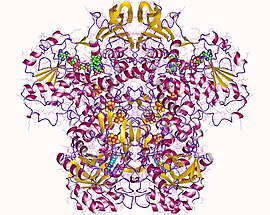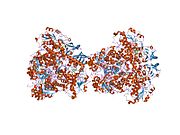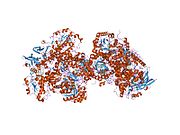Dihydropyrimidine dehydrogenase (NADP+)
| dihydropyrimidine dehydrogenase (NADP+) | |||
|---|---|---|---|
 Dihydroprymidine dehydrogenase dimer, Sus scrofa | |||
| Identifiers | |||
| EC no. | 1.3.1.2 | ||
| CAS no. | 9029-01-0 | ||
| Alt. names | Dihydrothymine dehydrogenase | ||
| Databases | |||
| IntEnz | IntEnz view | ||
| BRENDA | BRENDA entry | ||
| ExPASy | NiceZyme view | ||
| KEGG | KEGG entry | ||
| MetaCyc | metabolic pathway | ||
| PRIAM | profile | ||
| PDB structures | RCSB PDB PDBe PDBsum | ||
| Gene Ontology | AmiGO / QuickGO | ||
| |||
| DPYD | |||||||
|---|---|---|---|---|---|---|---|
 | |||||||
| Identifiers | |||||||
| Aliases | DPYD, DHP, DHPDHASE, DPD, dihydropyrimidine dehydrogenase | ||||||
| External IDs | OMIM: 612779 MGI: 2139667 HomoloGene: 85 GeneCards: DPYD | ||||||
| |||||||
| |||||||
| |||||||
| |||||||
| Orthologs | |||||||
| Species | Human | Mouse | |||||
| Entrez | |||||||
| Ensembl | |||||||
| UniProt | |||||||
| RefSeq (mRNA) | |||||||
| RefSeq (protein) | |||||||
| Location (UCSC) | Chr 1: 97.08 – 98 Mb | Chr 3: 118.56 – 119.43 Mb | |||||
| PubMed search | [3] | [4] | |||||
| Wikidata | |||||||
| |||||||
In enzymology, a dihydropyrimidine dehydrogenase (NADP+) (EC 1.3.1.2) is an enzyme that catalyzes the chemical reaction
- 5,6-dihydrouracil + NADP+ uracil + NADPH + H+
Thus, the two substrates of this enzyme are 5,6-dihydrouracil and NADP+, whereas its 3 products are uracil, NADPH, and H+.
In humans the enzyme is encoded by the DPYD gene.[5][6] It is the initial and rate-limiting step in pyrimidine catabolism.[citation needed] It catalyzes the reduction of uracil and thymine.[7] It is also involved in the degradation of the chemotherapeutic drugs 5-fluorouracil and tegafur.[8] It also participates in beta-alanine metabolism and .
Terminology[]
The systematic name of this enzyme class is 5,6-dihydrouracil:NADP+ 5-oxidoreductase.
Other names in common use include:
- dihydrothymine dehydrogenase
- dihydrouracil dehydrogenase (NADP+)
- 4,5-dihydrothymine: oxidoreductase
- DPD
- DHPDH
- dehydrogenase, dihydrouracil (nicotinamide adenine dinucleotide, phosphate)
- DHU dehydrogenase
- hydropyrimidine dehydrogenase
- dihydropyrimidine dehydrogenase (NADP+)
Structural studies[]
As of late 2007, 5 structures have been solved for this class of enzymes, with PDB accession codes 1GT8, 1GTE, 1GTH, 1H7W, and 1H7X.
Function[]
The protein is a pyrimidine catabolic enzyme and the initial and rate-limiting factor in the pathway of uracil and thymidine catabolism. Genetic deficiency of this enzyme results in an error in pyrimidine metabolism associated with thymine-uraciluria and an increased risk of toxicity in cancer patients receiving 5-fluorouracil chemotherapy.[6]
Interactive pathway map[]
Click on genes, proteins and metabolites below to link to respective articles.[§ 1]
- ^ The interactive pathway map can be edited at WikiPathways: "FluoropyrimidineActivity_WP1601".
See also[]
- Dihydropyrimidine dehydrogenase deficiency, a genetic disorder
- Cancer pharmacogenomics
References[]
- ^ Jump up to: a b c GRCh38: Ensembl release 89: ENSG00000188641 - Ensembl, May 2017
- ^ Jump up to: a b c GRCm38: Ensembl release 89: ENSMUSG00000033308 - Ensembl, May 2017
- ^ "Human PubMed Reference:". National Center for Biotechnology Information, U.S. National Library of Medicine.
- ^ "Mouse PubMed Reference:". National Center for Biotechnology Information, U.S. National Library of Medicine.
- ^ Takai S, Fernandez-Salguero P, Kimura S, Gonzalez FJ, Yamada K (December 1994). "Assignment of the human dihydropyrimidine dehydrogenase gene (DPYD) to chromosome region 1p22 by fluorescence in situ hybridization". Genomics. 24 (3): 613–4. doi:10.1006/geno.1994.1680. PMID 7713523.
- ^ Jump up to: a b "Entrez Gene: DPYD dihydropyrimidine dehydrogenase".
- ^ Chung T, Na J, Kim YI, Chang DY, Kim YI, Kim H, Moon HE, Kang KW, Lee DS, Chung JK, Kim SS, Suh-Kim H, Paek SH, Youn H (2016). "Dihydropyrimidine Dehydrogenase Is a Prognostic Marker for Mesenchymal Stem Cell-Mediated Cytosine Deaminase Gene and 5-Fluorocytosine Prodrug Therapy for the Treatment of Recurrent Gliomas". Theranostics. 6 (10): 1477–90. doi:10.7150/thno.14158. PMC 4955049. PMID 27446484.
- ^ Caudle KE, Thorn CF, Klein TE, Swen JJ, McLeod HL, Diasio RB, Schwab M (December 2013). "Clinical Pharmacogenetics Implementation Consortium guidelines for dihydropyrimidine dehydrogenase genotype and fluoropyrimidine dosing". Clinical Pharmacology and Therapeutics. 94 (6): 640–5. doi:10.1038/clpt.2013.172. PMC 3831181. PMID 23988873.
Further reading[]
- Hoff PM, Royce M, Medgyesy D, Brito R, Pazdur R (December 1999). "Oral fluoropoyrimidines". Seminars in Oncology. 26 (6): 640–6. PMID 10606257.
- Schneider HB, Becker H (May 2003). "Impact of dihydropyrimidine dehydrogenase on 5-fluorouracil treatment in cancer patients". European Journal of Medical Research. 8 (5): 226–8. PMID 12844478.
- Omura K (June 2003). "Clinical implications of dihydropyrimidine dehydrogenase (DPD) activity in 5-FU-based chemotherapy: mutations in the DPD gene, and DPD inhibitory fluoropyrimidines". International Journal of Clinical Oncology. 8 (3): 132–8. doi:10.1007/s10147-003-0330-z. PMID 12851836. S2CID 22593228.
- Lee W, Lockhart AC, Kim RB, Rothenberg ML (February 2005). "Cancer pharmacogenomics: powerful tools in cancer chemotherapy and drug development". The Oncologist. 10 (2): 104–11. doi:10.1634/theoncologist.10-2-104. PMID 15709212.
- Lu ZH, Zhang R, Diasio RB (August 1992). "Purification and characterization of dihydropyrimidine dehydrogenase from human liver". The Journal of Biological Chemistry. 267 (24): 17102–9. doi:10.1016/S0021-9258(18)41899-6. PMID 1512248.
- Porter DJ, Chestnut WG, Merrill BM, Spector T (March 1992). "Mechanism-based inactivation of dihydropyrimidine dehydrogenase by 5-ethynyluracil". The Journal of Biological Chemistry. 267 (8): 5236–42. doi:10.1016/S0021-9258(18)42757-3. PMID 1544906.
- Dupuis A, Skehel JM, Walker JE (March 1991). "A homologue of a nuclear-coded iron-sulfur protein subunit of bovine mitochondrial complex I is encoded in chloroplast genomes". Biochemistry. 30 (11): 2954–60. doi:10.1021/bi00225a032. PMID 1901022.
- Eggink G, Engel H, Vriend G, Terpstra P, Witholt B (March 1990). "Rubredoxin reductase of Pseudomonas oleovorans. Structural relationship to other flavoprotein oxidoreductases based on one NAD and two FAD fingerprints". Journal of Molecular Biology. 212 (1): 135–42. doi:10.1016/0022-2836(90)90310-I. PMID 2319593.
- Tuchman M, Roemeling RV, Hrushesky WA, Sothern RB, O'Dea RF (1989). "Dihydropyrimidine dehydrogenase activity in human blood mononuclear cells". Enzyme. 42 (1): 15–24. doi:10.1159/000469002. PMID 2528450.
- Diasio RB, Beavers TL, Carpenter JT (January 1988). "Familial deficiency of dihydropyrimidine dehydrogenase. Biochemical basis for familial pyrimidinemia and severe 5-fluorouracil-induced toxicity". The Journal of Clinical Investigation. 81 (1): 47–51. doi:10.1172/JCI113308. PMC 442471. PMID 3335642.
- Yokota H, Fernandez-Salguero P, Furuya H, Lin K, McBride OW, Podschun B, Schnackerz KD, Gonzalez FJ (September 1994). "cDNA cloning and chromosome mapping of human dihydropyrimidine dehydrogenase, an enzyme associated with 5-fluorouracil toxicity and congenital thymine uraciluria". The Journal of Biological Chemistry. 269 (37): 23192–6. doi:10.1016/S0021-9258(17)31638-1. PMID 8083224.
- Lu Z, Zhang R, Diasio RB (November 1993). "Dihydropyrimidine dehydrogenase activity in human peripheral blood mononuclear cells and liver: population characteristics, newly identified deficient patients, and clinical implication in 5-fluorouracil chemotherapy". Cancer Research. 53 (22): 5433–8. PMID 8221682.
- Vreken P, Van Kuilenburg AB, Meinsma R, Smit GP, Bakker HD, De Abreu RA, van Gennip AH (1997). "A point mutation in an invariant splice donor site leads to exon skipping in two unrelated Dutch patients with dihydropyrimidine dehydrogenase deficiency". Journal of Inherited Metabolic Disease. 19 (5): 645–54. doi:10.1007/BF01799841. PMID 8892022. S2CID 10835574.
- Johnson MR, Wang K, Tillmanns S, Albin N, Diasio RB (May 1997). "Structural organization of the human dihydropyrimidine dehydrogenase gene". Cancer Research. 57 (9): 1660–3. PMID 9135003.
- Fernandez-Salguero PM, Sapone A, Wei X, Holt JR, Jones S, Idle JR, Gonzalez FJ (April 1997). "Lack of correlation between phenotype and genotype for the polymorphically expressed dihydropyrimidine dehydrogenase in a family of Pakistani origin". Pharmacogenetics. 7 (2): 161–3. doi:10.1097/00008571-199704000-00012. PMID 9170156.
- Vreken P, Van Kuilenburg AB, Meinsma R, van Gennip AH (July 1997). "Identification of novel point mutations in the dihydropyrimidine dehydrogenase gene" (PDF). Journal of Inherited Metabolic Disease. 20 (3): 335–8. doi:10.1023/A:1005357307122. PMID 9266349. S2CID 3060557.
- Vreken P, Van Kuilenburg AB, Meinsma R, van Gennip AH (December 1997). "Dihydropyrimidine dehydrogenase (DPD) deficiency: identification and expression of missense mutations C29R, R886H and R235W". Human Genetics. 101 (3): 333–8. doi:10.1007/s004390050637. PMID 9439663. S2CID 24362516.
- Ogura K, Nishiyama T, Takubo H, Kato A, Okuda H, Arakawa K, Fukushima M, Nagayama S, Kawaguchi Y, Watabe T (January 1998). "Suicidal inactivation of human dihydropyrimidine dehydrogenase by (E)-5-(2-bromovinyl)uracil derived from the antiviral, sorivudine". Cancer Letters. 122 (1–2): 107–13. doi:10.1016/S0304-3835(97)00377-7. PMID 9464498.
- FRITZSON P (1960). "Properties and assay of dihydrouracil dehydrogenase of rat liver". J. Biol. Chem. 235 (3): 719–25. doi:10.1016/S0021-9258(19)67929-9. PMID 13825299.
- Shiotani T, Weber G (1981). "Purification and properties of dihydrothymine dehydrogenase from rat liver". J. Biol. Chem. 256 (1): 219–24. doi:10.1016/S0021-9258(19)70122-7. PMID 7451435.
- Genes on human chromosome 1
- EC 1.3.1
- NADPH-dependent enzymes
- Enzymes of known structure
- EC 1.3 stubs











